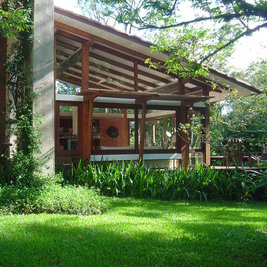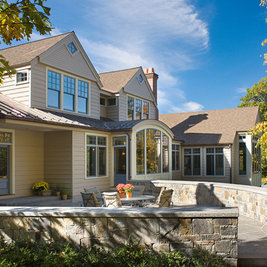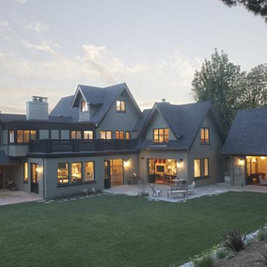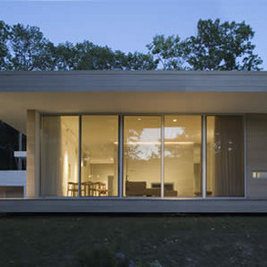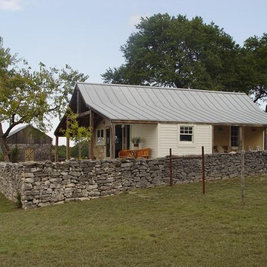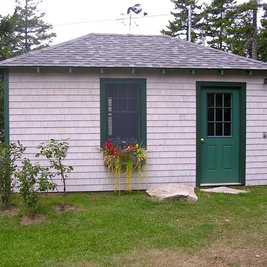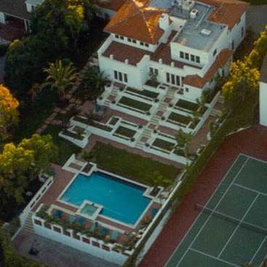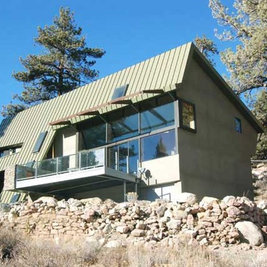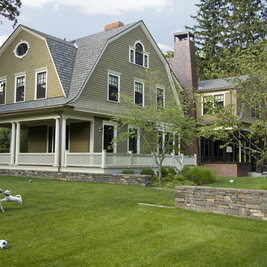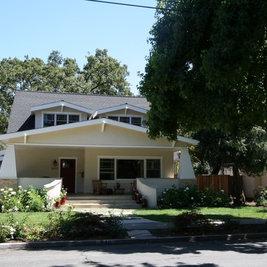(According to Houzz.com)
10 Different Types of Roofs for your Home
The Butterfly roof is cool, unusual and architecturally interesting. Her ideabook got me thinking about all of the different types of roof shapes that there are to choose from.This is definitely something to keep in mind when designing and building your own home. Of course, many of us move into homes that have already been built and we have to accept the shape of roof that the home comes with. Nevertheless, we can learn to pay attention to the different benefits of certain roof types when choosing and renovating our houses.
There are many different types of roofs, which you'll start to notice as you begin to pay more attention to roofing. Many of us just think in terms of flat roofs and pitched roofs but there are many different gradations and styles of each. And this doesn't even take into consideration the different options for roofing materials (which I'll need to cover one day in a future ideabook!)
What is your favorite roof style?
10. Skillion Roof. This type of roof is a
single sloping roof surface. You can think of it as just one half of a
triangular roof or you can think of it as a flat roof that has been
inclined slightly. It is often used on just a portion of the home. One
modern architectural option is to use skillion roofing on a multi-level
home to create unique shapes and patterns for the home's exterior.
9. Arched Roof. The arched roof is
typically only used on a portion of the home (as seen here) but
definitely adds a great aesthetic touch the architecture of the house.
8. Cross Gabled Roof. There are many types
of gabled roofs (roofs that essentially look like triangles from the
front of the home). I enjoy the cross gabled roof which is used in homes
with extra wings so that each portion of the home has its own
triangular gabled roof as seen in this photo.
7. Flat Roof. This type of roof is
obviously easy to identify! The benefits of a flat roof include that
it's easier to construct, safer if you're going to stand on top of it
and generally more accessible. The main drawback is that this type of
roof requires more maintenance than other roofs in large part because
debris will gather on the roof with nowhere to go.
6. Bonnet Roof. This type of room is
similar to the pyramid roof or hip roof. The difference, as you can see
here , is that two of the slides slope out an angle. The most common
purpose for this is to cover a veranda or outdoor porch area.
5. Hip Roof. This roof is very similar to
the pyramid roof. The difference is that instead of coming to a point at
the top the four sides meet at a ridge or a flat spot like we see here.
This is architecturally more practical.
4. Pyramid Roof. As the name suggests, this
is a type of roof that is shaped like a pyramid. We see it here on two
different portions of this extravagant home. This type of roof is
usually used either on small portions, like this, or on small structures
such as a garage or pool house.
3. Saltbox. This is one of my favorite roof
types just because it looks so interesting from the exterior. It is an
asymmetrical long pitched roof with one short side and one very long
side. Often times this results in a home that is one story in height on
one side of the building and two stories on the other side. What a neat
design!
2. Gambrel. This type of roof is very
similar to the Mansard Roof. The core differences are that the gambrel
has vertical gable ends and the roof hangs over the facade of the home
whereas the Mandrel Roof does not. Additionally this one is
Dutch-inspired instead of French.
1. Mansard Roof. This type of roof is made
up of four slopes, two on each side of the home. The lower slope is a
steeper, more vertical slope than the upper slope. The upper slope may
or may not be visible from the ground. This French style of roof allows
for additional living space or storage space at the top of the house.
(According to Angie's List)
Types of Roofing
Although asphalt shingle is the
most common and generally least expensive roofing material, residential
roofs can also be made of tile, wood, slate and metal.
Asphalt shingles
These
shingles are the most popular with roofers and homeowners, as they are
durable and relatively inexpensive. Other benefits include the wide
variety of colors and styles, ease of installation and suitability for a
wide range of temperatures. Asphalt shingles also provide reliable
waterproofing.
Asphalt shingle roofs should last about 20 years on average, depending on whether you live in an area with intense sunlight or temperature extremes, which can reduce life span. You can purchase asphalt shingle roofs with a 50-year life expectancy and roofs made of materials like concrete tile, metal shingles, slate or other natural materials can last many years longer.
Disadvantages of asphalt shingles include a shorter life than many heavier tiles, especially if they are walked on. Dark asphalt shingles are prone to fading and tend to exhibit inconsistencies in color. The black marks are caused by algae, which doesn't survive well in direct sunlight. Homeowners can get rid discoloration by applying a sodium hypochlorite bleach solution and rinsing it off fresh water. Homeowners can also look for an algae-resistant shingle such as 3M's Algae Block, which contains copper granules that can help prevent new growth.
Asphalt shingle roofs should last about 20 years on average, depending on whether you live in an area with intense sunlight or temperature extremes, which can reduce life span. You can purchase asphalt shingle roofs with a 50-year life expectancy and roofs made of materials like concrete tile, metal shingles, slate or other natural materials can last many years longer.
Disadvantages of asphalt shingles include a shorter life than many heavier tiles, especially if they are walked on. Dark asphalt shingles are prone to fading and tend to exhibit inconsistencies in color. The black marks are caused by algae, which doesn't survive well in direct sunlight. Homeowners can get rid discoloration by applying a sodium hypochlorite bleach solution and rinsing it off fresh water. Homeowners can also look for an algae-resistant shingle such as 3M's Algae Block, which contains copper granules that can help prevent new growth.
Slate and tile roof shingles
Slate
may be the answer if you are looking for a sophisticated roofing
material for an upscale home. Advantages to slate include its natural
appearance, fire resistance, invulnerability to rot, ease of maintenance
and an expected life of 100 years. Slate is available in a variety of
colors and styles.
Disadvantages of slate tiles include their weight and cost, and the high degree of expertise needed for installation. Slate tiles are easily broken underfoot, complicating gutter cleaning and rooftop maintenance.
Ceramic roofing tiles give a house character and are generally durable. Advances in the manufacturing process make the tiles resistant to fading. Ceramic tiles are fireproof, and quality tiles should last 50 to 70 years.
Disadvantages to ceramic roofing tiles include their unsuitability for climates with fluctuating weather. Ceramic tiles are prone to erosion under these conditions. While the tiles are durable, they are also fragile. High winds can damage them, as will walking on the tiles.
Disadvantages of slate tiles include their weight and cost, and the high degree of expertise needed for installation. Slate tiles are easily broken underfoot, complicating gutter cleaning and rooftop maintenance.
Ceramic roofing tiles give a house character and are generally durable. Advances in the manufacturing process make the tiles resistant to fading. Ceramic tiles are fireproof, and quality tiles should last 50 to 70 years.
Disadvantages to ceramic roofing tiles include their unsuitability for climates with fluctuating weather. Ceramic tiles are prone to erosion under these conditions. While the tiles are durable, they are also fragile. High winds can damage them, as will walking on the tiles.
Metal roofing
Metal roofs
are becoming increasingly viable, as metal shingles are low
maintenance, lightweight and more environmentally friendly. However,
installation can be tricky and requires a contractor with experience
installing a metal roof.
As a metal roof starts to lose its shine, repainting is an option as long as the roof's structural integrity is in good shape. It usually costs less to repaint a metal roof than to replace it.
As a metal roof starts to lose its shine, repainting is an option as long as the roof's structural integrity is in good shape. It usually costs less to repaint a metal roof than to replace it.
Flat roof
Flat roofs
can require a great deal of maintenance. As the homeowner, you are
responsible for ensuring it stays watertight. The roof must be cleaned
regularly to prevent leaves and debris from clogging the drain. Also,
the sun will gradually cause the roof to degrade, as flat roofs located
in environments where the temperature can go from hot to cold in a short
period of time are more vulnerable to damage.
Flat roofs are typically less expensive to install than sloped roofs. They may provide a safer option, as there is less chance of falling off when you are on top of a flat roof. They are usually easy to access and can allow you to achieve a certain visual appearance.
Although some newer green-friendly solutions reduce heat absorption for flat roofs and offer greater leak-proof protection, often the coating doesn't last a long time. A flat roof may need replacing within 15 years and the replacement cost can be high.
Flat roofs are typically less expensive to install than sloped roofs. They may provide a safer option, as there is less chance of falling off when you are on top of a flat roof. They are usually easy to access and can allow you to achieve a certain visual appearance.
Although some newer green-friendly solutions reduce heat absorption for flat roofs and offer greater leak-proof protection, often the coating doesn't last a long time. A flat roof may need replacing within 15 years and the replacement cost can be high.
Wood shakes and cedar shingles
Manufactured
from naturally renewable resources, wood shake shingles are a
green-friendly roofing choice. This is especially true if they are
constructed from recycled wood or harvested in an environmentally sound
way. Wood shakes have been listed as a preferred environmental choice
because these materials produce minimal impact on the quality of water
runoff and are stable with a useful life of around 30 years or more,
making them a solid investment in environmental responsibility for many
homeowners.
Checking in with your state’s office of insurance regulation will be an important factor in determining repair or replacement.
Editor's Note: This is an updated version of an article originally published Oct. 9, 2015.
Checking in with your state’s office of insurance regulation will be an important factor in determining repair or replacement.
Editor's Note: This is an updated version of an article originally published Oct. 9, 2015.
5 Types of Roofing Shingles
Finding the best kind of shingles for your home as well as your budget is a great start to installing a new roof.
It's important to consider the pros and cons of several different types of roof shingles and the relative cost of each roofing material, as well as consult with a local roofing contractor to determine which shingles work best for your house and in your part of the country. Here's a look at some commonly used roofing materials:
1. Asphalt shingles
Generally
the most frequently used, asphalt shingles are relatively inexpensive.
Plus, if you purchase coated asphalt shingles, they may meet the Energy
Star standards for a cool roof and earn you a rebate. Three-tab asphalt
shingles are thinner and slightly less expensive than laminated or
architectural asphalt shingles. And though they tend to be less
expensive, asphalt shingles have a relatively short life span of 20 to
30 years.
2. Tile shingles
These
shingles have a unique appearance characteristic of the Southwest
states and colonial Spanish architecture. Tile shingles are some of the
most expensive to purchase and install, but also are one of the
longest-lasting and durable materials on the market, lasting more than
50 years. However, The National Roofing Contractors Association cautions
that some homes might not be able to structurally support the weight of
tile shingles.
The cost of replacing your roof will depend not only on the roofing material, but also on the roofer you hire. Look up reviews on Angie's List and recommendations for service providers in your area. Call several of the reputable roofing companies and request a quote for the roofing materials you are considering.
The cost of replacing your roof will depend not only on the roofing material, but also on the roofer you hire. Look up reviews on Angie's List and recommendations for service providers in your area. Call several of the reputable roofing companies and request a quote for the roofing materials you are considering.
This roof features stone-coated metal tiles. (Photo courtesy of Angie's List member Surujnarine S., Jacksonville, Florida)
3. Metal roofs
Appropriate
for homes with especially flat or steep rooflines, metal roofing can
either be solid metal or constructed metal shingles. Low-end galvanized
metal roofs are relatively inexpensive, but can last up to 50 years.
Metal roofs are becoming a popular option in many areas of the country.
Once seen largely in the Northwest and Rocky Mountain regions,
metal roofs are making an inroad into the Midwest and southern United
States.
4. Wood shingles
More
expensive than asphalt, wood shingles are known to be more
aesthetically appealing because of their natural appearance. If you
choose a hardwood, such as cedar or redwood, the shingles should last at
least 30 years and sometimes as long as 50 years.
Vermont slate roofing gives this home a European look. (Photo courtesy of Angie's List member Theresa D., Altadena, California)
5. Slate shingles
This
material is especially popular in the Northeastern portion of the
United States, because the slate from which the shingles are made is
quarried there. These shingles are extremely durable, with a life span
of up to 50 years. With proper mainteance,
it's not uncommon to find old farmhouses that are leak-free and still
have their original slate-shingled roofs. If your budget doesn't allow
for real slate shingles, you can always consider a synthetic slate
product, which has a similar appearance, but a slightly shorter life
span.
(According to Wikipedia)
Roofing material is the outermost layer on the roof of a building, sometimes self-supporting, but generally supported by an underlying structure. A building's roofing material provides shelter from the natural elements. The outer layer of a roof shows great variation dependent upon availability of material, and the nature of the supporting structure. Those types of roofing material which are commercially available range from natural products such as thatch and slate to commercially produced products such as tiles and polycarbonate sheeting. Roofing materials may be placed on top of a secondary water-resistant material called underlayment. Roofing is an Industry where you work on roofs. This Industry is a high risk industry due to the injuries that you can sustain in this job environment. Roofing is focus on the upper layer of a house or building. Roofing on a house is considered residential and building are commercial. Roofing on a government building you get paid pavilion wage.
Materials
The weatherproofing material is the topmost or outermost layer, exposed to the weather. Many materials have been used as weatherproofing material:
- Thatch is roofing made of plant stalks in overlapping layers
- Wheat straw, widely used in England, France and other parts of Europe
- Seagrass, used in coastal areas where there are estuaries such as Scotland. Has a longer life than straw. Claimed to have a life in excess of 60 years.
- Rye straw, commonly used in a barn.
- Raffia palm leaves:A well organised raffia palm leaves is mainly used as roof houses in Nigeria especially among the Igbos.
- Rice straw, commonly used in Eastern Asia.
- Water reed, commonly used in Ireland for Thatching.
- Shingle is the generic term for a roofing material that is in many overlapping sections, regardless of the nature of the material.
- Wood shingle, shingles sawn from bolts of wood such as red cedar which has a life expectancy of up to 30 years. However, young growth red cedar has a short life expectancy and high cost. Also in the eastern United States white cedar and some hardwoods which were very durable roofing found in Colonial Australian and American colonial architecture, its use is now limited to building restoration. All wood shingles benefit by being allowed to breathe (dry out from below).
- Shake (shingle), Are different than wood shingles in that they are split on one side and sawed on the back side. Commonly referred to as "resawn Shakes". A cedar shake is NOT the same as a cedar shingle.[1]
- Slate. High cost with a life expectancy of 80 to 400 years. See the article slate industry for an overview including names of quarries. Some of the famous quarries where the highest quality slate comes from that are available in Australia are Bethesda in Wales and areas of Spain.
- Asphalt shingle made of bitumen embedded in an organic or fiberglass mat, usually covered with colored, man-made ceramic grit. Cheaper than slate or tiles. The reduced cost of this particular style of roofing is especially apparent in its application and removal. Installation is very streamlined and a rapid process.[2] Depending on the size of the roof and the experience of the crew, it is possible to remove old shingles and apply new ones on 2-3 houses in one day.[citation needed] Life span varies. Use only on slanted roofs.[3]
- Rubber shingle, alternative to asphalt shingle, slate, shake or tile. Made primarily of rubber, often recycled tire-derived rubber. Other typical ingredients include binders, UV (ultraviolet light) inhibitors and color. Warranted and designed to last at least 50 years in most cases.
- Asbestos shingles. Very long lifespan, fireproof and low cost but now rarely used because of health concerns.[4]
- Stone slab. Heavy stone slabs (not to be confused with slate) 1–2 inches thick were formerly used as roofing tiles in some regions in England, the Alps, and Scandinavia. Stone slabs require a very heavyweight roof structure, but their weight makes them stormproof. An obsolete roofing material, now used commercially only for building restoration.
- Solar shingle
- Metal shakes or shingles. Long life. High cost, suitable for roofs of 3/12 pitch or greater. Because of the flexibility of metal, they can be manufactured to lock together, giving durability and reducing assembly time. For a discussion of copper system shingles, see Copper in architecture#Wall cladding.
- Ceramic tile. High cost, life of more than 100 years.
- Imbrex and tegula, style dating back to ancient Greece and Rome.
- Monk and Nun, a style similar to Imbrex and tegula, but basically using two Imbrex tiles.
- Dutch roof tiles, Netherlands
- British Ceramic Tile, United Kingdom
- Mangalore tiles, India
- Membrane roofing. Membrane roofing is in large sheets, generally fused in some way at the joints to form a continuous surface.
- Thermoset membrane (e.g. EPDM rubber). Synthetic rubber sheets adhered together with contact adhesive or tape. Primary application is big box stores with large open areas.
- Thermoplastics (e.g. PVC, TPO, CSPE) – Plastic sheets welded together with hot air, creating one continuous sheet membrane. They can be re-welded with the exception of CSPE. Lends itself well to both big box and small roof application because of its hot air weldability. This membrane is installed by two methods: 1.) Rolls of membrane are attached to the ridged insulation using a bonding adhesive; 2.) The edge of each roll is fastened through ridged insulation into structural deck, and the proceeding roll is lapped over the fasteners. The overlap is then heat-welded with hot air to create a mechanically fastened thermoplastic roof. PVC is also known as IB.Vinyl roof membrane.
- Liquid roofing
- Asphalt roll roofing including single and double coverage types.
- Bituminous waterproofing is a general term for:
- Modified bitumen – heat-welded, asphalt-adhered or installed with adhesive. Asphalt is mixed with polymers such as APP or SBS, then applied to fiberglass and/or polyester mat, seams sealed by locally melting the asphalt with heat, hot mopping of asphalt, or adhesive. Lends itself well to most applications.
- Built-up roof – Multiple plies of salt-saturated organic felt or coated fiberglass felts. Plies of felt are adhered with hot asphalt, coal tar pitch or adhesive. Although the roof membrane can be left bare, it is typically covered with a thick coat of the waterproofing material and covered with gravel. The gravel provides protection from ultra-violet degradation, stabilizes the temperature changes, protects surface of the roof and increases the weight of the roof system to resist wind blow-off.
- Fabric
- polyester.
- PTFE, (synthetic fluoropolymer) embedded in fibreglass.
- Metal roofing.
- Corrugated galvanised iron is Galvanised steel manufactured with wavy corrugations to resist lateral flexing and fitted with exposed fasteners. Widely used for low cost and durability. Sheds are normally roofed with this material. Gal iron or Corro was the most extensively used roofing material of 20th century Australia, now replaced in popularity by steel with longer-lasting, coloured, alloy coatings.
- Copper roofs can last for hundreds of years. Copper roofing offers durability, ease of fabrication, lighter weight than some other roofing materials, can be curved, low maintenance, corrosion resistance, low thermal movement, lightning protection, radio frequency shielding, and are 100% recyclable. Copper roofs have a high initial cost but very long lifetime: tests on European copper roofs from the 18th Century showed that, in theory, copper roofs can last one thousand years.[5] Another advantage of copper roofing systems is that they are relatively easy to repair.
- Standing-seam metal with concealed fasteners.
- Mechanically seamed metal with concealed fasteners contains sealant in seams for use on very low sloped roofs, suitable for roofs of low pitch such as 0.5/12 to 3/12 pitch.
- Flat-seam metal with or without soldered seams.
- Steel coated with a coloured alloy of zinc and aluminium.
- Stone-coated metal roofing.
- Concrete or fibre cement, usually reinforced with fibres of some sort.
- may also be in the form of concrete tiles.
- Structural concrete can also be used for flat roof constructions. There are three main categories, precast/prestressed, cast-in-place and shell. There are many types of precast/prestressed concrete roofing. The followings are the most common types.[6]
- Double tees are the most common products for short spans up to 60 feet (18 m)
- Hollow-core slabs are used when there is a need for flushed ceiling.
- T-beams are similar to double tees but can be used for span ranging from 30 feet (9.1 m) to 100 feet (30 m).
- Joists and planks are combination of using prestressed joists with prestressed planks. Keystone-shape joists can be used for up to 36-foot (11 m) spans and tee-shape joists can be used for up to 60-foot (18 m) span.
Underlayments
- Tar paper and felt paper
- Synthetic underlayment
- Ice and water shield
- Insolation(Dens deck)
- Fire Sheet
Drip edge is a metal installed to the edges of a roof deck, after the roofing material is installed. The metal may be galvanized, steel, aluminum, charcoal, white (painted or not), copper and possibly others.
See Also
- Roof
- Domestic roof construction
- List of roof shapes
- Board roof
- Building construction
- Building insulation
- Building envelope
- Grouted roof
- Sod roof
- Birch-bark roof
- Stone roofs such as on a clochán or trullo
- Mud roofs such as on beehive house
- Sedum a plant used in green roofs
